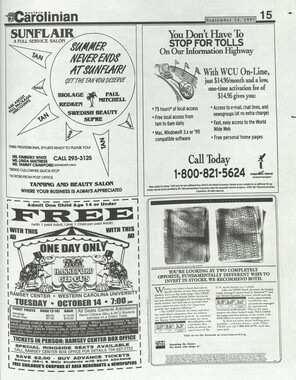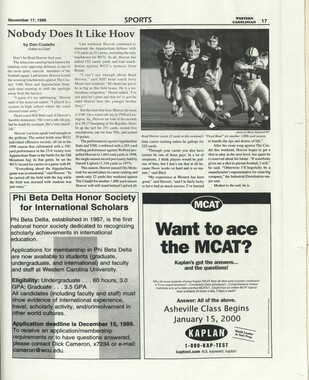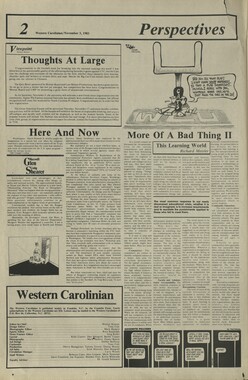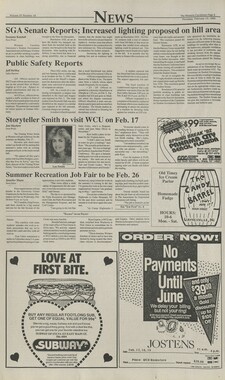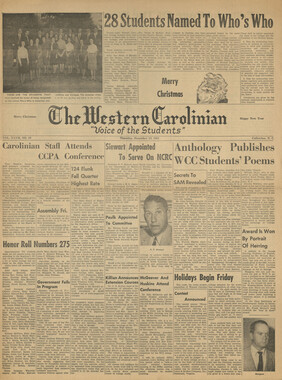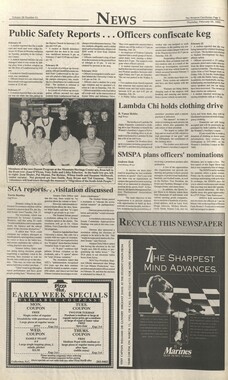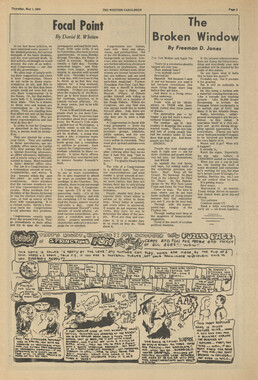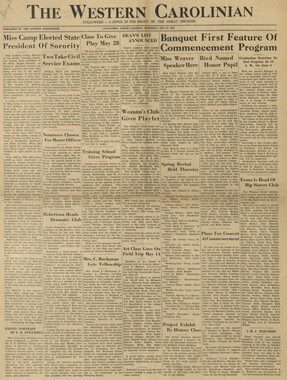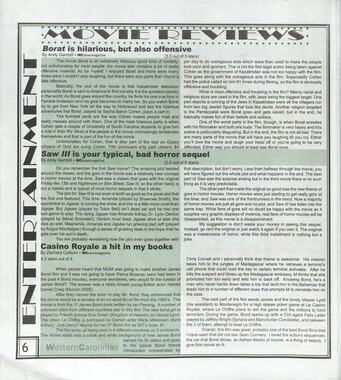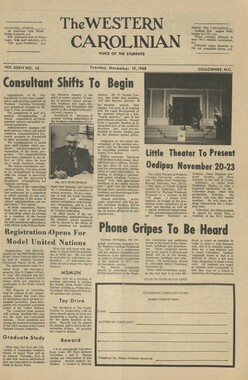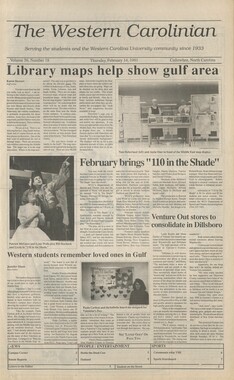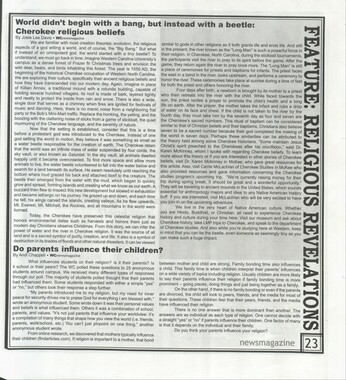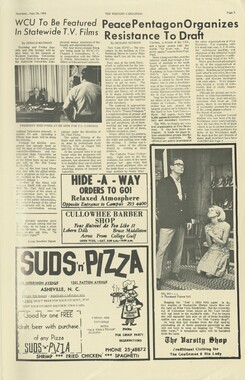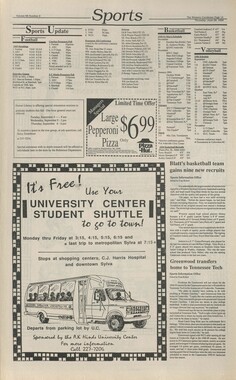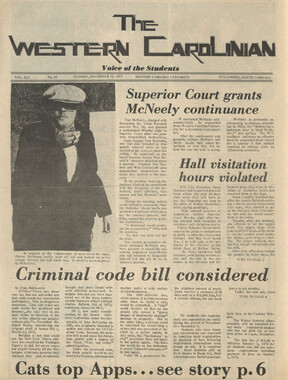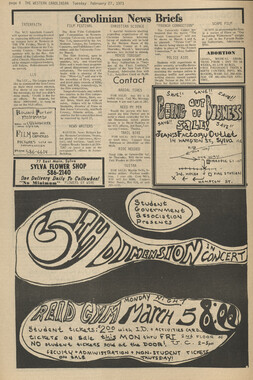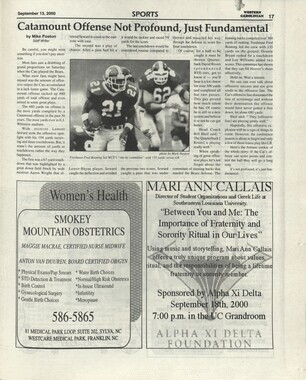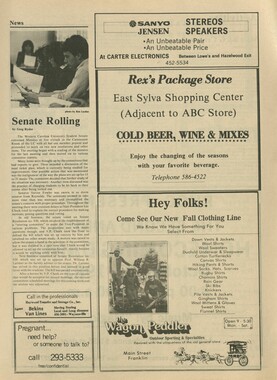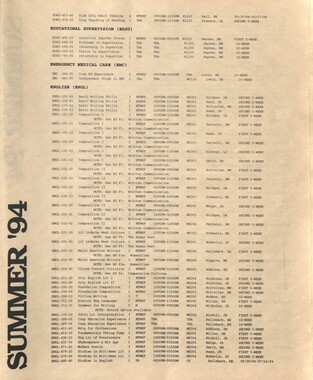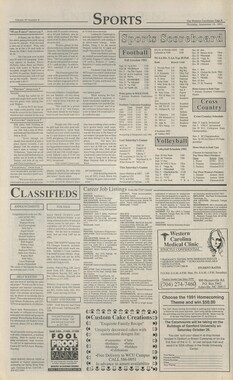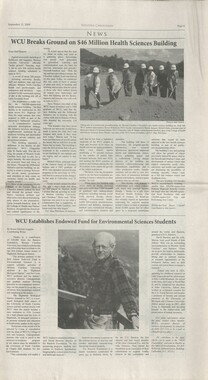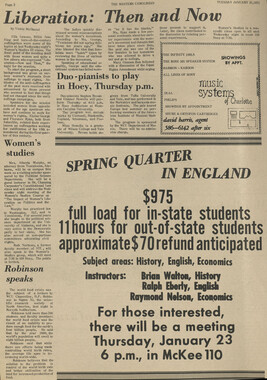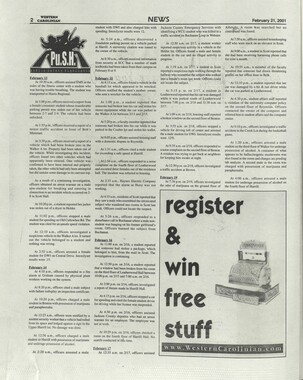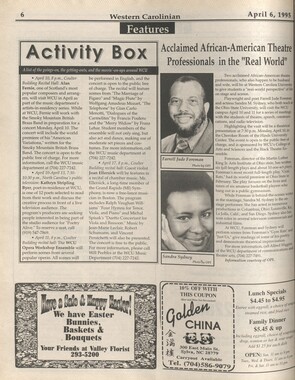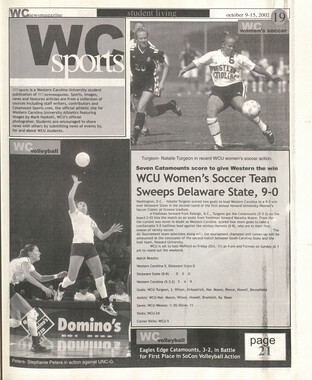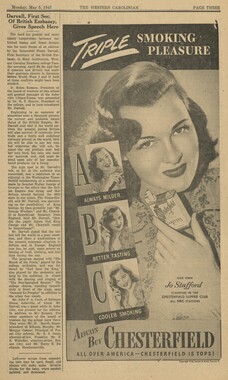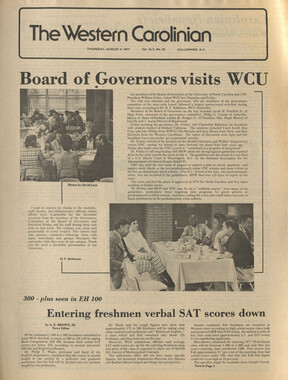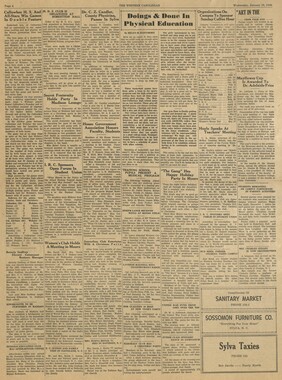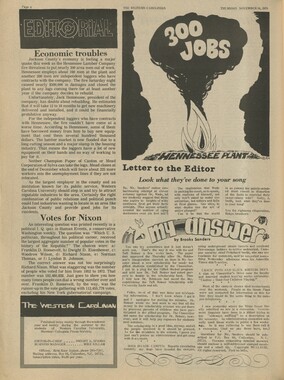Western Carolina University (20)
View all
- Canton Champion Fibre Company (2308)
- Cherokee Traditions (291)
- Civil War in Southern Appalachia (165)
- Craft Revival (1942)
- Great Smoky Mountains - A Park for America (2946)
- Highlights from Western Carolina University (430)
- Horace Kephart (941)
- Journeys Through Jackson (159)
- LGBTQIA+ Archive of Jackson County (85)
- Oral Histories of Western North Carolina (314)
- Picturing Appalachia (6873)
- Stories of Mountain Folk (413)
- Travel Western North Carolina (160)
- Western Carolina University Fine Art Museum Vitreograph Collection (129)
- Western Carolina University Herbarium (92)
- Western Carolina University: Making Memories (738)
- Western Carolina University Publications (2491)
- Western Carolina University Restricted Electronic Theses and Dissertations (146)
- Western North Carolina Regional Maps (71)
- World War II in Southern Appalachia (131)
University of North Carolina Asheville (6)
View all
- Allanstand Cottage Industries (62)
- Appalachian National Park Association (53)
- Bennett, Kelly, 1890-1974 (1463)
- Berry, Walter (76)
- Brasstown Carvers (40)
- Carver, George Washington, 1864?-1943 (26)
- Cathey, Joseph, 1803-1874 (1)
- Champion Fibre Company (233)
- Champion Paper and Fibre Company (297)
- Cherokee Indian Fair Association (16)
- Cherokee Language Program (22)
- Crowe, Amanda (40)
- Edmonston, Thomas Benton, 1842-1907 (7)
- Ensley, A. L. (Abraham Lincoln), 1865-1948 (275)
- Fromer, Irving Rhodes, 1913-1994 (70)
- George Butz (BFS 1907) (46)
- Goodrich, Frances Louisa (120)
- Grant, George Alexander, 1891-1964 (96)
- Heard, Marian Gladys (60)
- Kephart, Calvin, 1883-1969 (15)
- Kephart, Horace, 1862-1931 (313)
- Kephart, Laura, 1862-1954 (39)
- Laney, Gideon Thomas, 1889-1976 (439)
- Masa, George, 1881-1933 (61)
- McElhinney, William Julian, 1896-1953 (44)
- Niggli, Josephina, 1910-1983 (10)
- North Carolina Park Commission (105)
- Osborne, Kezia Stradley (9)
- Owens, Samuel Robert, 1918-1995 (11)
- Penland Weavers and Potters (36)
- Roberts, Vivienne (15)
- Roth, Albert, 1890-1974 (142)
- Schenck, Carl Alwin, 1868-1955 (1)
- Sherrill's Photography Studio (2565)
- Southern Highland Handicraft Guild (127)
- Southern Highlanders, Inc. (71)
- Stalcup, Jesse Bryson (46)
- Stearns, I. K. (213)
- Thompson, James Edward, 1880-1976 (226)
- United States. Indian Arts and Crafts Board (130)
- USFS (683)
- Vance, Zebulon Baird, 1830-1894 (1)
- Weaver, Zebulon, 1872-1948 (58)
- Western Carolina College (230)
- Western Carolina Teachers College (282)
- Western Carolina University (2008)
- Western Carolina University. Mountain Heritage Center (18)
- Whitman, Walt, 1819-1892 (10)
- Wilburn, Hiram Coleman, 1880-1967 (73)
- Williams, Isadora (3)
- Cain, Doreyl Ammons (0)
- Crittenden, Lorraine (0)
- Rhodes, Judy (0)
- Smith, Edward Clark (0)
- Appalachian Region, Southern (2569)
- Asheville (N.C.) (1923)
- Avery County (N.C.) (26)
- Blount County (Tenn.) (195)
- Buncombe County (N.C.) (1672)
- Cherokee County (N.C.) (283)
- Clay County (N.C.) (555)
- Graham County (N.C.) (236)
- Great Smoky Mountains National Park (N.C. and Tenn.) (519)
- Haywood County (N.C.) (3569)
- Henderson County (N.C.) (70)
- Jackson County (N.C.) (4912)
- Knox County (Tenn.) (35)
- Knoxville (Tenn.) (13)
- Lake Santeetlah (N.C.) (10)
- Macon County (N.C.) (420)
- Madison County (N.C.) (215)
- McDowell County (N.C.) (39)
- Mitchell County (N.C.) (132)
- Polk County (N.C.) (35)
- Qualla Boundary (982)
- Rutherford County (N.C.) (76)
- Swain County (N.C.) (2182)
- Transylvania County (N.C.) (270)
- Watauga County (N.C.) (12)
- Waynesville (N.C.) (86)
- Yancey County (N.C.) (72)
- Aerial Photographs (3)
- Aerial Views (60)
- Albums (books) (4)
- Articles (1)
- Artifacts (object Genre) (228)
- Bibliographies (1)
- Biography (general Genre) (2)
- Cards (information Artifacts) (38)
- Clippings (information Artifacts) (191)
- Copybooks (instructional Materials) (3)
- Crafts (art Genres) (622)
- Depictions (visual Works) (21)
- Design Drawings (1)
- Drawings (visual Works) (185)
- Envelopes (73)
- Exhibitions (events) (1)
- Facsimiles (reproductions) (1)
- Fiction (general Genre) (4)
- Financial Records (12)
- Fliers (printed Matter) (67)
- Glass Plate Negatives (381)
- Guidebooks (2)
- Internegatives (10)
- Interviews (815)
- Land Surveys (102)
- Letters (correspondence) (1013)
- Manuscripts (documents) (618)
- Maps (documents) (177)
- Memorandums (25)
- Minutes (administrative Records) (59)
- Negatives (photographs) (6090)
- Newsletters (1290)
- Newspapers (2)
- Notebooks (8)
- Occupation Currency (1)
- Paintings (visual Works) (1)
- Pen And Ink Drawings (1)
- Periodicals (193)
- Personal Narratives (10)
- Photographs (12976)
- Plans (maps) (1)
- Poetry (5)
- Portraits (4568)
- Postcards (329)
- Programs (documents) (181)
- Publications (documents) (2443)
- Questionnaires (65)
- Relief Prints (26)
- Sayings (literary Genre) (1)
- Scrapbooks (282)
- Sheet Music (2)
- Slides (photographs) (402)
- Songs (musical Compositions) (2)
- Sound Recordings (796)
- Specimens (92)
- Speeches (documents) (18)
- Tintypes (photographs) (8)
- Transcripts (322)
- Video Recordings (physical Artifacts) (23)
- Text Messages (0)
- A.L. Ensley Collection (275)
- Appalachian Industrial School Records (7)
- Appalachian National Park Association Records (336)
- Axley-Meroney Collection (2)
- Bayard Wootten Photograph Collection (20)
- Bethel Rural Community Organization Collection (7)
- Blumer Collection (5)
- C.W. Slagle Collection (20)
- Canton Area Historical Museum (2110)
- Carlos C. Campbell Collection (462)
- Cataloochee History Project (64)
- Cherokee Studies Collection (4)
- Daisy Dame Photograph Album (5)
- Daniel Boone VI Collection (1)
- Doris Ulmann Photograph Collection (112)
- Elizabeth H. Lasley Collection (1)
- Elizabeth Woolworth Szold Fleharty Collection (4)
- Frank Fry Collection (95)
- George Masa Collection (173)
- Gideon Laney Collection (452)
- Hazel Scarborough Collection (2)
- Hiram C. Wilburn Papers (28)
- Historic Photographs Collection (236)
- Horace Kephart Collection (861)
- Humbard Collection (33)
- Hunter and Weaver Families Collection (1)
- I. D. Blumenthal Collection (4)
- Isadora Williams Collection (4)
- Jesse Bryson Stalcup Collection (47)
- Jim Thompson Collection (224)
- John B. Battle Collection (7)
- John C. Campbell Folk School Records (80)
- John Parris Collection (6)
- Judaculla Rock project (2)
- Kelly Bennett Collection (1482)
- Love Family Papers (11)
- Major Wiley Parris Civil War Letters (3)
- Map Collection (12)
- McFee-Misemer Civil War Letters (34)
- Mountain Heritage Center Collection (4)
- Norburn - Robertson - Thomson Families Collection (44)
- Pauline Hood Collection (7)
- Pre-Guild Collection (2)
- Qualla Arts and Crafts Mutual Collection (12)
- R.A. Romanes Collection (681)
- Rosser H. Taylor Collection (1)
- Samuel Robert Owens Collection (94)
- Sara Madison Collection (144)
- Sherrill Studio Photo Collection (2558)
- Smoky Mountains Hiking Club Collection (616)
- Stories of Mountain Folk - Radio Programs (374)
- The Reporter, Western Carolina University (510)
- Venoy and Elizabeth Reed Collection (16)
- WCU Gender and Sexuality Oral History Project (32)
- WCU Mountain Heritage Center Oral Histories (25)
- WCU Oral History Collection - Mountain People, Mountain Lives (71)
- WCU Students Newspapers Collection (1923)
- Western North Carolina Tomorrow Black Oral History Project (69)
- William Williams Stringfield Collection (2)
- Zebulon Weaver Collection (109)
- African Americans (390)
- Appalachian Trail (35)
- Artisans (521)
- Cherokee art (84)
- Cherokee artists -- North Carolina (10)
- Cherokee language (21)
- Cherokee pottery (101)
- Cherokee women (208)
- Church buildings (189)
- Civilian Conservation Corps (U.S.) (111)
- College student newspapers and periodicals (2012)
- Dams (107)
- Dance (1023)
- Education (222)
- Floods (61)
- Folk music (1015)
- Forced removal, 1813-1903 (2)
- Forest conservation (220)
- Forests and forestry (1184)
- Gender nonconformity (4)
- Great Smoky Mountains National Park (N.C. and Tenn.) (181)
- Hunting (45)
- Landscape photography (25)
- Logging (119)
- Maps (83)
- Mines and mineral resources (8)
- North Carolina -- Maps (18)
- Paper industry (38)
- Postcards (255)
- Pottery (135)
- Railroad trains (72)
- Rural electrification -- North Carolina, Western (3)
- School integration -- Southern States (2)
- Segregation -- North Carolina, Western (5)
- Slavery (5)
- Sports (452)
- Storytelling (243)
- Waterfalls -- Great Smoky Mountains (N.C. and Tenn.) (66)
- Weaving -- Appalachian Region, Southern (280)
- Wood-carving -- Appalachian Region, Southern (328)
- World War, 1939-1945 (173)
Western Carolinian Volume 40 Number 10
Item
Item’s are ‘child’ level descriptions to ‘parent’ objects, (e.g. one page of a whole book).
-
-
Page 4 THE WESTERN CAROLINIAN TUESDAY OCTOBER 1, 1974 Stop Mead's pollution Time never fails to show that a lot of optimism is self-delusion at best, false advertising at worst. In February of 1928, The Asheville Times reported, in a "special dispatch" from Sylva, that work was being carried forward rapidly on construction of the new Sylva Paper Board company which would use chestnut wood and bark from the Parsons Tanning company next door. The Times story said, "Persons living below the plant, along the river, need have no fear of contamination from the refuse, according to E. L. McKee, vice-president and manager of both industries." It quoted Mr. McKee's reassurance. "The newly-perfected process which the plant will make use of insures against contamination to the point where even the fish will not be harmed. Pollution will be inconsequental." Mr. McKee was probably convinced his statement was absolutely true. Unfortunately for everybody concerned, it was not. The paper mill's discharge into the Tuckaseigee River soon turned it into a black, open, foam-covered sewer. By 1956, the plant was using 5,000,000 gallons of river water a day. The Tuckaseigee was not fit for fish, or anything else. This week Lee Powers of Lake Lure, a member of North Carolina's Environmental Management Commission, described the enterprise at Sylva as "the worst polluted in the state." The commission's other members seem to share Powers' opinion. They promised after a meeting at Raleigh Thursday that unless new information is received which could change its decision, it will shut down the plant by the end of this year, as it announced two years ago it would. That information conceivably could come from protests of Sylva people at a public hearing the commission will hold there Oct. 16. But the plant, which has been owned and operated by the Mead Corporation of Dayton, Ohio, since its beginning, has had persistently critical notice. When the EMC (then the Board of Water and Air Resources) delivered its two year ultimatum to clean up the air and water pollution or close down by the end of 1974, a Mead official said the plant would close. The cost of necessary pollution control measures, he said, would be too high in the face of the plant's built- in inefficiencies and other economic considerations. This July, however, Mead announced it would continue the Sylva plant as a re-pulping operation for waste paper, if the Environmental Commission would approve plans for a liquid waste treatment facility that would be in operation early in 1976. The plant would end its woodpulping operation next March. (It sold 40,000 acres of Jackson County forest it owned to a Miami developer soon after announcing the decision to close.) The Environmental Management Commission does not seem overly impressed by Mead's announced intentions. At Thursday's meeting, two of its members said the company has done little or nothing to abate its pollution in the past year and a half. A lot of water has gone down the river since E. L. McKee promised safety to the fish 46 years ago. A lot of pollution has gone into the once pure mountain air, from this plant and others. A lot has changed, also, since 1928, when most people still regarded pollution as a minor nuisance, if they thought about it at all. Surely by now, we trust, a giant corporation like Mead, one of the 10 largest papermakers in the United States, is willing to be completely committed to the urgent necessity of reducing pollution far below its present level. From all reports, the company has indeed dragged its feet in doing anything about the Sylva plant. But announcements from company spokesmen in July and August seem based on better judgements than Mr. McKee's promise of 1928. The company by now also must realize the state means what it says about cleaning up—and no ifs, ands or buts. But Mead is entitled to one more condition, at least. If it can produce substantial proof that the proposed changes are being arranged, the extra time should be granted. Western North Carolina wants its business and industry, but it is now more obvious to all of us that it has got to be clean, or we won't have it. (Reprinted from the Asheville Citizen.) kH's fcfeeK-to 2 Tvtf) feVwen discussing r worldly aftairs (Culiouhetydty * you Know, fr/rWiiee is a really far-out pl^' a bustling, husHinge^4 .ever-moving place— dlvJdys on the Truffaut's 'Jules, Jim' treats eye, ear, mind m^rnm tTTA.ffHJTT. by Terry Neinhuis JULES AND JEM (1961), directed by Francois Truffaut Jules and Jim become fast friends in Paris, circa 1910, and chase after sexual adventure until they become enraptured by a statue of a woman with a tranquil, inscrutable smile and then meet a woman who embodies the ineffable quality of the statue. Both are enamoured by her, but when she takes to Jules first, both men accept that she "belongs" to Jules. At the same time, Jim is settling down to contemplate marriage with Gilberte, and with competitiveness eliminated between the two men, Jules, Catherine, and Jim are able to cavort joyously through Paris together. The relationship between Jules and Catherine is not without its tempestous moments, but just before the outbreak of the war, the two are married. The point of the film is to show what happens after the marriage. Catherine is a highly spirited mercurial, impulsive woman who came to Jules with abundant sexual experience. When Jim returns after the war to visit the couple, he learns that the marriage has been a failure. Catherine has become bored and has taken to a succession of lovers. It is obvious that she is interested in Jim, and Jules is so enslaved by her that he begs Jim to win Catherine so that he might continue to see her. Jim, still entranced by Catherine, chooses her over Gilberte and moves in to form a "menage a trois." This new coupling, however, is turbulent. Neither Jim nor Catherine can accept the other's interest in other parties, and they eventually separate, with Catherine returning to Jules, and Jim to Gilberte. Catherine reacts violently when Jim tells her he is going to marry Gilberte, and at the end of the film Jules, Catherine, and Jim are lunching at a cafe when Catherine offers Jim a ride in her car. "Watch us Jules," she shouts, and then gaily drives the car off a bridge and into the river, killing herself and Jim. Despite the title, the film's primary interest is with the mysterious and effervescently changeable Catherine. By the third reel, Truffaut has shifted our perspective away from the two men and settled it on the question of how we are to respond to the woman. Ultimately, we are to see her as a pathetically insecure woman, starved for affection, petulant if not the center • of attention, and insistent that the world must satisfy her whims. Truffaut contrasts Cath erine with Therese and Denise, who are merely empty-headed sensualists, but finally makes us see that Catherine is basically hedonistic and power-hungry, a woman who insists on enslaving but who will not be enslaved. A Freudian interpretation might suggest that Catherine attempts to destroy the intimacy between the two men because she is jealous of it. Whatever, the mastery of Truffaut's filmmaking lies in his ability to create a powerful attraction to Catherine as a basis for balancing this judgment. Early in the film, we are taken by her wonderful spirit and entertain the notion that she might be just too angelic for this world. Those thoughts are not cancelled at the end but coexist with our final judgment to make our final impression rich and stimulating. The film's insight into human experience centers on the realization that a steady diet of sexual adventure is incompatible with a serious, enduring relationship between men and women. Caring entails jealousy. Jules submits to Catherine's double standard because it is his only chance to keep her near0 Jim learns to resist and refuses to be her slave, and she kills both of them as a final assertion of her existential power. Near the end of the movie, Jim observes that "new rules are beautiful, but it's more practical to obey old ones." Practicality is not part of Catherine's system, but it is part of Truffaut's. Catherine and Jim are cremated and their ashes placed in urns. In the last line of the film. Truffaut reports that "Catherine wanted her (ashes) to be cast to the winds, but it was not permitted." Jules, the survivor, the uninspiring, but decent and steady, domesticated male, is our eventual resting place. He is the most brutalized of the three but the only one to gain full understanding and peace. He buries Catherine and Jim with a sense of relief, left with his daughter and the idea of his friendship with Jim, finally free of the warring passions brought to him by Catherine: "Jules would no longer dread her infidelity or fear her death." This film will be highly entertaining for all. Henri Serre and Oskar Werner (a William F. Buckley look-alike) have magnificently expressive faces and bodies, and hardly enough can be said of Jeanne Moreau's talents. It is a treat on the eye, the ear, the mind, and at $1 (or $5 for the whole series) a treat on the inflationary pocket book as well: 7:30 Tuesday night, Forsyth auditorium.
Object
Object’s are ‘parent’ level descriptions to ‘children’ items, (e.g. a book with pages).
-
The Western Carolinian is Western Carolina University's student-run newspaper. The paper was published as the Cullowhee Yodel from 1924 to 1931 before changing its name to The Western Carolinian in 1933.
-
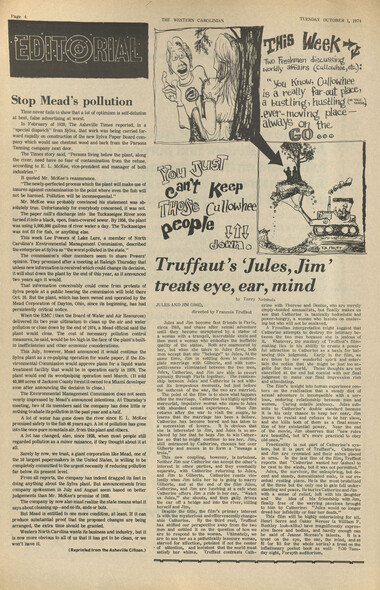

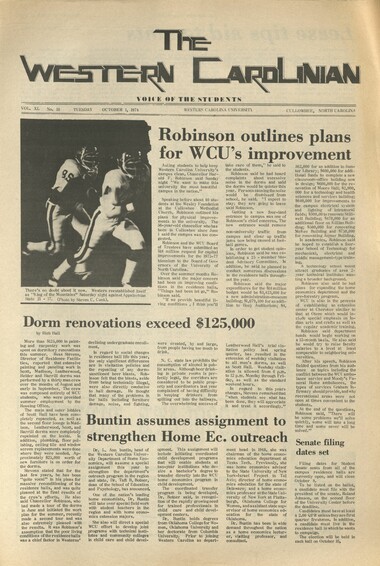

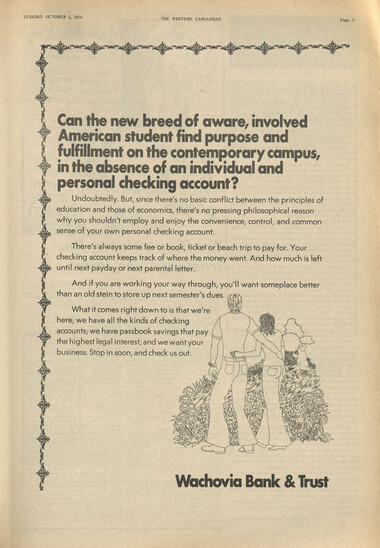


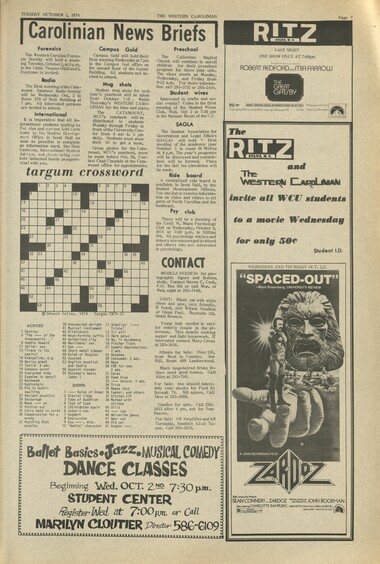

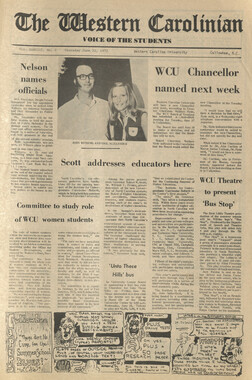
![hl_westerncarolinian_2004_[vol69_no03]_04.jpg](/media/w400h300/wcu_publications/hl_westerncarolinian_2004_[vol69_no03]_04.jpg)
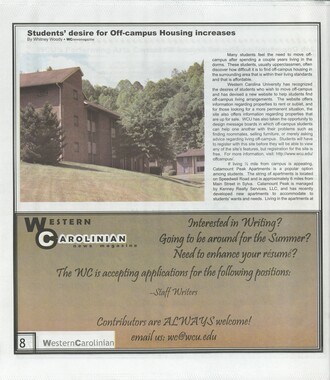
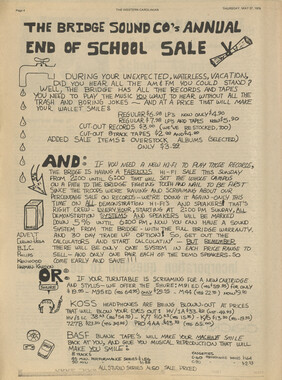

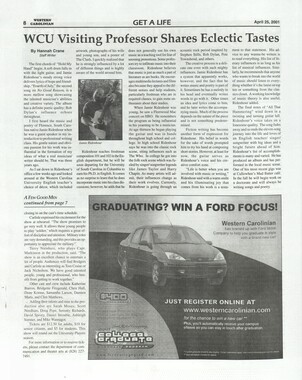
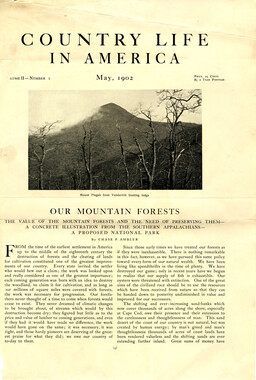
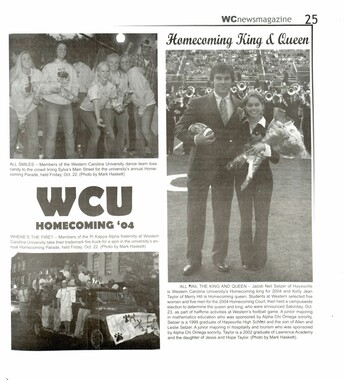
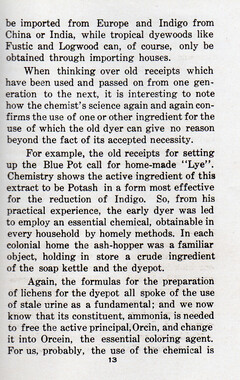


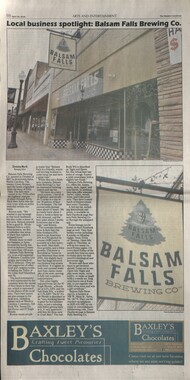
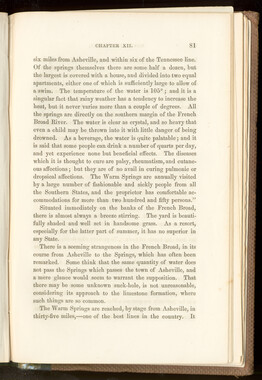
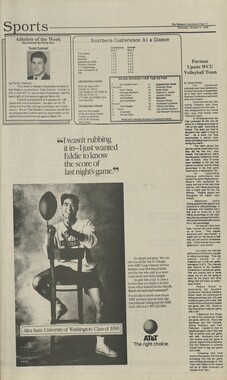
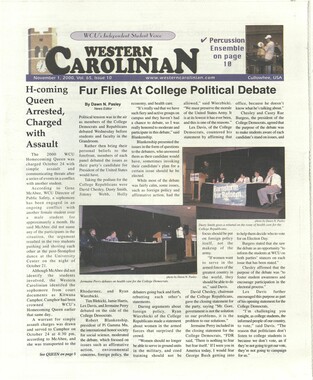
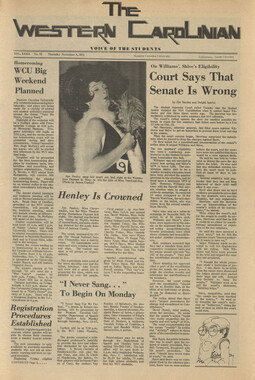
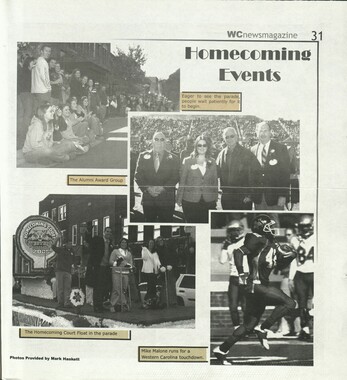
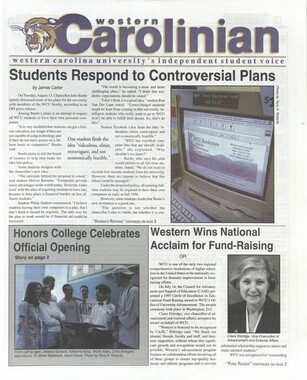
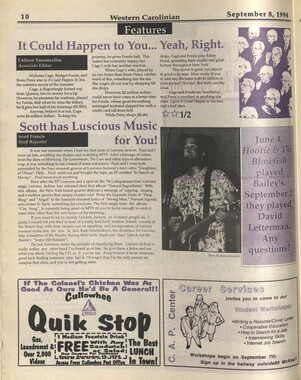
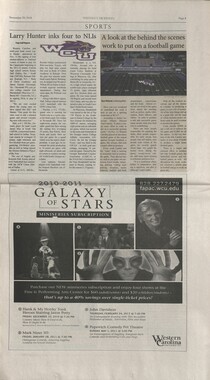
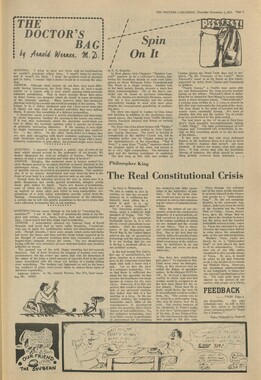
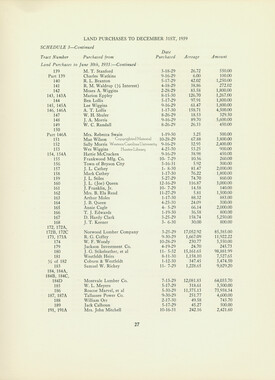
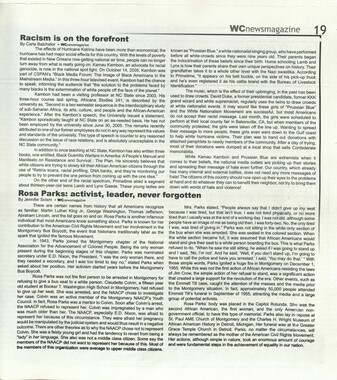

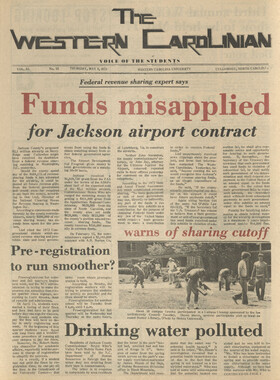
![hl_westerncarolinian_2008-09-26[10-27]_vol74_no03[04]_09.jpg](/media/w400h300/wcu_publications/hl_westerncarolinian_2008-09-26[10-27]_vol74_no03[04]_09.jpg)
